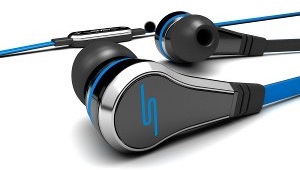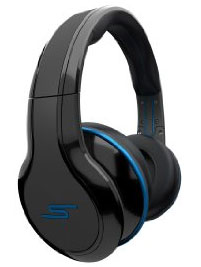 QVC featured 50 Cent recently, promoting his STREET by 50 line of headphones. It was the in-ear version of the STREETs (pictured on the left) that we saw on the segment they did on 50 Cent on CBS Sunday Morning. Though it is probably safe to assume he marketed both types – the full headphones and the earbuds – on QVC.
QVC featured 50 Cent recently, promoting his STREET by 50 line of headphones. It was the in-ear version of the STREETs (pictured on the left) that we saw on the segment they did on 50 Cent on CBS Sunday Morning. Though it is probably safe to assume he marketed both types – the full headphones and the earbuds – on QVC.
So what are the STREET by 50 headphones? They are mostly the same thing as other headphones in this category – stylish, great-sounding headphones that are part of a rapper’s personal line, and also have the ability to control (talk, listen, adjust volume, etc.) your mobile phone via the detachable wire.

The main difference here though, is that the STREETs only offer passive noise-reduction. This just means that the headphones can block out certain noises, mainly middle-to-high frequency stuff, just by means of the ear cup covering your ears. Active noise-cancellation, however (which is what the Beats Studio by Dr. Dre headphones offer). With active, the electronics in the headphones actually sample the ambient noise and then produce an exact negative of that audio and feed it back into the headphones, essentially eliminating the noise altogether.
The in-ear versions don’t offer much in the way of any type of noise cancellation, mainly because they can’t cover your ears. Though you can certainly block out a lot of stuff just by cranking the music really loud:).
To get your own pair of either type of STREET by 50, click below.
Audio Formats And Compression
The most important difference between audio file formats is the type of compression (that’s data compression – not to be confused with audio level compression, which you can review in our article Should You Use Compression In Audio Recording? if you’d like). There are uncompressed formats (.wav, .aiff), lossless compressed formats (.flac), and lossy compressed formats (.mp3, .wma). As you might guess, uncompressed formats are in their original size and quality. These formats are best for recording, but due to their larger size, may not be appropriate for distribution. Lossless formats compress the size of the file without losing any of the quality, and lossy formats compress size with some loss of quality. Knowing the key differences between the formats can help you to choose the right file type for each step in your production process.
Get a review on the mp3 format from my article What Is An MP3?
You can read the article describing the other formats here: http://www.audio-issues.com/home-recording-studio/demystifying-audio-formats-what-format-should-you-record-in/
Vintage Synths For The iPad
The iPad and other tablets are great for emulating vintage synthesizers. Between their portability, touch interface, and computing power, today’s tablets are a perfect match to recreate yesteryear’s synthesizers. The low cost of these apps compared to an actual vintage synthesizer allows for much more variety in composition.
You can read about some great iPad synthesizer apps here: http://evolver.fm/2013/03/18/the-ipad-is-where-vintage-synthesizers-go-to-live
Plughugger Soundsets On Sale Until March 31st
Plughugger is now offering a selection of soundsets for only 0.99 euro (about $1.28 USD) through March 31st. These soundsets may be exactly what your current project needs, or they may just be a fun novelty for your sound library. At this price, either is perfectly acceptable.
You can read more about these soundsets and listen to demos here: http://rekkerd.org/plughugger-launches-soundset-sale/
Steps You Might Have Missed Creating A Home Studio
The applications of home recording are vast. Some of them only require audio tracks to be produced, but others may also occasionally need video recordings. Just as a poorly produced audio track can make a bad impression, a video with poor lighting or low resolution can also reflect negatively on you professionally.
You can read about some tips for setting up a home recording studio for both audio and video here: https://www.udemy.com/blog/tips-tricks-for-creating-a-home-recording-studio/